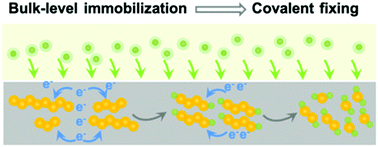当前位置:
X-MOL 学术
›
Energy Environ. Sci.
›
论文详情
Our official English website, www.x-mol.net, welcomes your
feedback! (Note: you will need to create a separate account there.)
Covalent fixing of sulfur in metal–sulfur batteries
Energy & Environmental Science ( IF 32.4 ) Pub Date : 2020/01/08 , DOI: 10.1039/c9ee03408k Ruopian Fang 1, 2, 3, 4 , Jiangtao Xu 1, 2, 3, 4, 5 , Da-Wei Wang 1, 2, 3, 4, 6
Energy & Environmental Science ( IF 32.4 ) Pub Date : 2020/01/08 , DOI: 10.1039/c9ee03408k Ruopian Fang 1, 2, 3, 4 , Jiangtao Xu 1, 2, 3, 4, 5 , Da-Wei Wang 1, 2, 3, 4, 6
Affiliation

|
With its earth abundance and two-electron-transfer reaction mechanism, sulfur has been driving the rapid growth of metal–sulfur batteries. The practical performance of metal–sulfur batteries, however, is restricted by the notorious electrode processes of sulfur (such as low conductivity, intermediate loss, mass crossover, etc.). Sulfur conversion reactions can be stabilized and promoted through a surface immobilization strategy via physical confinement and chemical adsorption effects. As an emerging method in the field, covalent-bonding sulfur materials have demonstrated promise for metal–sulfur batteries. The covalent fixing of sulfur reinforces the molecular interactions between sulfur and the cathode matrix at the bulk level. In this review, we attempt to address the covalent fixing concept on the basis of the emerging studies related to covalent sulfur-containing compounds and composites in various rechargeable metal–sulfur batteries. Firstly, we briefly discuss the classification of sulfur fixing strategies and identify the uniqueness of covalently stabilized sulfur for metal–sulfur batteries. Secondly, we summarize the state-of-the-art covalent sulfur-based materials as well as their synthetic chemistry. Thirdly, we focus on lithium–sulfur batteries that feature cathodes with covalent sulfur active materials, including reaction mechanisms and material innovations. Advances in alternative alkaline metal–sulfur battery systems (sodium–sulfur and potassium–sulfur) involving covalent fixing of sulfur are also discussed. Finally, the prospective opportunities of applying the covalent fixing strategy to optimize the sulfur redox process are commented on. This contribution is anticipated to place the covalent fixing of sulfur into the spotlight and to encourage more efforts in this challenging cross-disciplinary area of organic/polymer chemistry, materials science, electrochemistry and energy technologies.
中文翻译:

金属-硫电池中硫的共价固定
凭借其丰富的地球和两电子转移反应机理,硫一直在推动金属硫电池的快速增长。但是,金属-硫电池的实际性能受到臭名昭著的硫电极工艺(例如低电导率,中间损耗,质量交换等)的限制。可以通过表面固定策略通过以下方法稳定和促进硫转化反应:物理限制和化学吸附作用。作为该领域的一种新兴方法,共价键结合的硫材料已被证明可以用于金属硫电池。硫的共价固定在整体水平上增强了硫与阴极基质之间的分子相互作用。在这篇综述中,我们试图基于与各种可充电金属-硫电池中含共价硫的化合物和复合材料有关的新兴研究,来解决共价固定的概念。首先,我们简要讨论了固硫策略的分类,并确定了用于金属硫电池的共价稳定硫的独特性。其次,我们总结了最先进的共价硫基材料及其合成化学。第三,我们专注于锂-硫电池,其阴极具有共价硫活性材料,包括反应机理和材料创新。还讨论了涉及共价固定硫的替代性碱金属-硫电池系统(钠-硫和钾-硫)的进展。最后,评述了应用共价固定策略优化硫氧化还原工艺的潜在机会。预计这一贡献将使硫的共价固定成为人们关注的焦点,并鼓励在有机/聚合物化学,材料科学,电化学和能源技术这一具有挑战性的交叉学科领域做出更多努力。还讨论了涉及共价固定硫的替代性碱金属-硫电池系统(钠-硫和钾-硫)的进展。最后,评论了应用共价固定策略优化硫氧化还原工艺的潜在机会。预计这一贡献将使硫的共价固定成为人们关注的焦点,并鼓励在有机/聚合物化学,材料科学,电化学和能源技术这一具有挑战性的交叉学科领域中做出更多努力。还讨论了涉及硫的共价固定的替代性碱金属-硫电池系统(钠-硫和钾-硫)的进展。最后,评论了应用共价固定策略优化硫氧化还原工艺的潜在机会。预计这一贡献将使硫的共价固定成为人们关注的焦点,并鼓励在有机/聚合物化学,材料科学,电化学和能源技术这一具有挑战性的交叉学科领域中做出更多努力。
更新日期:2020-02-19
中文翻译:

金属-硫电池中硫的共价固定
凭借其丰富的地球和两电子转移反应机理,硫一直在推动金属硫电池的快速增长。但是,金属-硫电池的实际性能受到臭名昭著的硫电极工艺(例如低电导率,中间损耗,质量交换等)的限制。可以通过表面固定策略通过以下方法稳定和促进硫转化反应:物理限制和化学吸附作用。作为该领域的一种新兴方法,共价键结合的硫材料已被证明可以用于金属硫电池。硫的共价固定在整体水平上增强了硫与阴极基质之间的分子相互作用。在这篇综述中,我们试图基于与各种可充电金属-硫电池中含共价硫的化合物和复合材料有关的新兴研究,来解决共价固定的概念。首先,我们简要讨论了固硫策略的分类,并确定了用于金属硫电池的共价稳定硫的独特性。其次,我们总结了最先进的共价硫基材料及其合成化学。第三,我们专注于锂-硫电池,其阴极具有共价硫活性材料,包括反应机理和材料创新。还讨论了涉及共价固定硫的替代性碱金属-硫电池系统(钠-硫和钾-硫)的进展。最后,评述了应用共价固定策略优化硫氧化还原工艺的潜在机会。预计这一贡献将使硫的共价固定成为人们关注的焦点,并鼓励在有机/聚合物化学,材料科学,电化学和能源技术这一具有挑战性的交叉学科领域做出更多努力。还讨论了涉及共价固定硫的替代性碱金属-硫电池系统(钠-硫和钾-硫)的进展。最后,评论了应用共价固定策略优化硫氧化还原工艺的潜在机会。预计这一贡献将使硫的共价固定成为人们关注的焦点,并鼓励在有机/聚合物化学,材料科学,电化学和能源技术这一具有挑战性的交叉学科领域中做出更多努力。还讨论了涉及硫的共价固定的替代性碱金属-硫电池系统(钠-硫和钾-硫)的进展。最后,评论了应用共价固定策略优化硫氧化还原工艺的潜在机会。预计这一贡献将使硫的共价固定成为人们关注的焦点,并鼓励在有机/聚合物化学,材料科学,电化学和能源技术这一具有挑战性的交叉学科领域中做出更多努力。











































 京公网安备 11010802027423号
京公网安备 11010802027423号